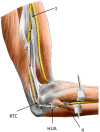Ulnar Neuropathy at the Elbow: From Ultrasound Scanning to Treatment
- PMID: 34054704
- PMCID: PMC8160369
- DOI: 10.3389/fneur.2021.661441
Ulnar Neuropathy at the Elbow: From Ultrasound Scanning to Treatment
Abstract
Ulnar neuropathy at the elbow (UNE) is commonly encountered in clinical practice. It results from either static or dynamic compression of the ulnar nerve. While the retroepicondylar groove and its surrounding structures are quite superficial, the use of ultrasound (US) imaging is associated with the following advantages: (1) an excellent spatial resolution allows a detailed morphological assessment of the ulnar nerve and adjacent structures, (2) dynamic imaging represents the gold standard for assessing the ulnar nerve stability in the retroepicondylar groove during flexion/extension, and (3) US guidance bears the capability of increasing the accuracy and safety of injections. This review aims to illustrate the ulnar nerve's detailed anatomy at the elbow using cadaveric images to understand better both static and dynamic imaging of the ulnar nerve around the elbow. Pathologies covering ulnar nerve instability, idiopathic cubital tunnel syndrome, space-occupying lesions (e.g., ganglion, heterotopic ossification, aberrant veins, and anconeus epitrochlearis muscle) are presented. Additionally, the authors also exemplify the scientific evidence from the literature supporting the proposition that US guidance is beneficial in injection therapy of UNE. The non-surgical management description covers activity modifications, splinting, neuromobilization/gliding exercise, and physical agents. In the operative treatment description, an emphasis is put on two commonly used approaches-in situ decompression and anterior transpositions.
Keywords: US-guidance; cubital tunnel syndrome; elbow; entrapment neuropathy; musculoskeletal; peripheral nerve; ulnar nerve (MeSH); ultrasound.
Copyright © 2021 Mezian, Jačisko, Kaiser, Machač, Steyerová, Sobotová, Angerová and Naňka.
Conflict of interest statement
The authors declare that the research was conducted in the absence of any commercial or financial relationships that could be construed as a potential conflict of interest.
Figures











References
-
- Mezian K, Steyeorova P, Vacek J, Navratil L. Introduction to neuromuscular ultrasound. Cesk Slov Neurol N. (2016) 79:656–61. 10.14735/amcsnn2016656 - DOI
Publication types
LinkOut - more resources
Full Text Sources
Other Literature Sources
Medical

